This feature is in two parts. There is a link to part II at the bottom of the page.
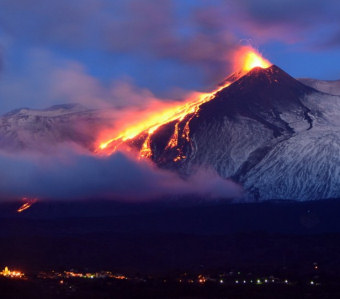
The spectacular photograph above (© Turi Caggegi) shows the most recent major eruption in 2013.
In fact, it is Etna that makes the wines of this region so special and so intriguing. It has an enormous influence, with a circumference of 140 kilometres it dominates wherever you travel in the region. On my May visit the ginestra – the yellow flowered ‘broom’ – and wild poppies were everywhere, carpeting the ground in vivid burst of Day-Glo colour. The volcanic soils are rich and fertile, with a top layer of decomposed lava and volcanic sand. The best vineyards are sited at 600 to 1100 metres on its slopes – in those places not piled high with huge mounds of lava from a recent very major eruption in 1981 (though Etna is almost constantly erupting: as recently as July 2011 the main centre for Etna tours was only saved from destruction by emergency action to divert a huge new lava flow).
These sandy volcanic soils also mean that Phylloxera, the devastating louse that destroyed so much of Europe’s vineyards, had little or no impact on Etna. There are many vineyards of ancient vines, over 100 years old, and all planted on their own roots without the need to graft onto Phylloxera-resistant rootstocks. Today there are around 70 producers on Etna, but as Michele Faro of the Pietradolce estate told me, “some are so small that really, they only bottle for family consumption.”
History, geography, climate & soils
Though vines have been grown on the island for centuries, it is only since 1968 that Sicily has had any DOC wines, with DOC Etna being its first, followed soon after by DOC Marsala from the west of the island. Historically, many producers will tell you that the rich red wines of Etna that were not drunk locally journeyed hundreds of miles north, to add some oomph to the weedier wines of old-style Bordeaux and other regions of northern Europe.
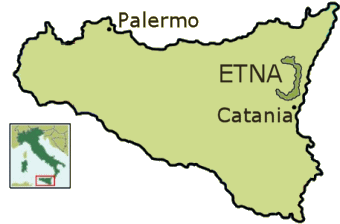
Guiseppe Russo commented that “One of the big challenges for wine growers is to really understand the nature of our volcanic soils.” It seems the very best terroirs are consistently found on really ancient lava, hundreds of thousands of years old, not on the lava from more recent eruptions. He also tells me that there is work going involving geologists, other scientists and agronomists to better understand these unusual soils.
Grapes and wine styles
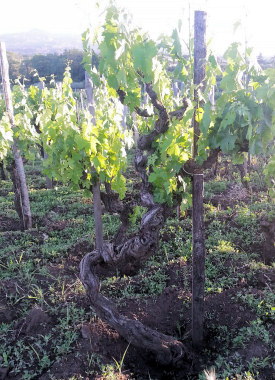
Red wine dominates, and more than one producer told me that Etna is often referred to locally as “Sicily’s Côte d’Or.” The character of Nerello Mascalese can give beautifully perfumed, rose, tar and truffle-scented wines, light in colour and body, and the echo of red Burgundy is obvious. Others are more reminiscent of Nebbiolo perhaps, and yet other, made with more extraction and body, can be darker, deeper and more chewy.
The estates
PIETRADOLCE
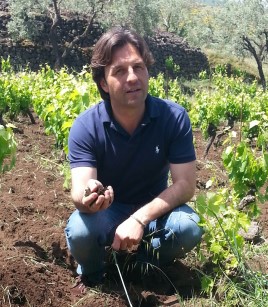
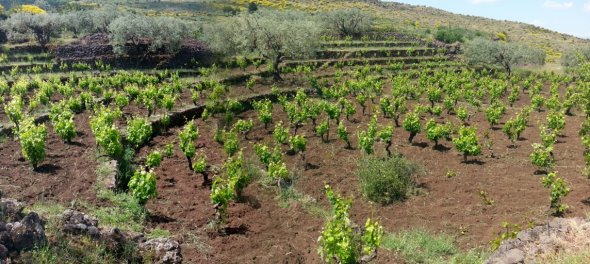
for tasting notes on 6 wines from Pietradolce
GIROLAMO RUSSO
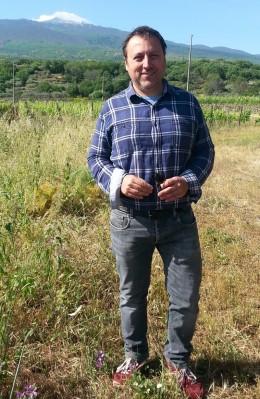
Guissepe was working happily as a professional musician when his dad died in 2004. He says he had no great interest in the family farm before then, but having taken over he moved very quickly into bottling wine rather than just growing grapes. His first vintage made in his own cellar was in 2007. A large glass section of the winery floor looks down on huge cement tanks once used for wine storage, which he plans to convert into a wine library in time. Now, stainless steel tanks occupy the cellar, as well as French oak barriques for maturation, though he says “Gradually I am moving to much bigger tonneaux.”
The farm consists of 15 hectares of vineyards in total, but spread over different areas, the wines bottled as ‘crus’ reflecting their area of production. He has 8ha of old vines planted between 650 and 750 metres, and from the beginning has always micro vinified each vineyard, and in some cases parcels within vineyards, separately. He produces 50,000 thousand bottles, but says “Each harvest is a long process as I want to get to know each parcel, and I pick each at least twice, leaving the best grapes on the vine for longer.” His white wines are made from white varieties scattered in old mixed plantings amongst the reds – he has no dedicated white wine vineyards. This is one of few estates I visited that is certified as organic, and Guissepe relies on wild yeasts for fermentation.
All of the old vines are Nerello Mascalese, but in some newer vineyards which he has planted he is disarmingly frank: “I also planted Nerello Cappuccio, though of course it is inferior. When I started I really didn’t know what I was doing, and as everyone had some Cappuccio in their historical vineyards, I thought I’d better plant some too.” The Cappuccio does not go into the three single vineyard wines. His 2000 bottles of white are made mostly from Carricante, but there are smatterings of other indigenous grapes. “As in all ancient vineyards,” he says, “When you walk through them you discover some very peculiar plants. But that is what gives the complexity.’
The old vineyards are all alberello trained, and everything pre-1960 is on its own roots. He has trained his newer vineyards on wires, in a cordon spur system, and says “Anyone who plants alberello today is crazy. It’s so expensive to maintainand does not guarantee better quality’
for tasting notes on 6 wines from Girolamo Russo
GRACI
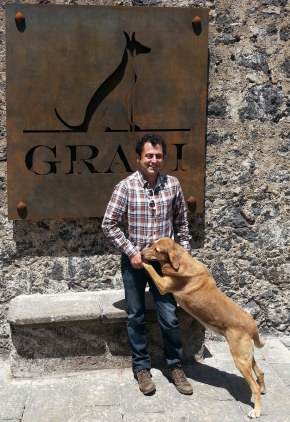
This is a land of ancient vines, that struggle to survive on lava soils, baking in summer with scarcely a drop of moisture, and near freezing in winter. “Up here exposition is vital,” Umberto tells me, “otherwise your grapes will never ripen. Plants up here grow more slowly and grapes are much smaller. One of our biggest tasks is keeping the grass under control, as it is such a fire risk in summer, the ground is so dry and hot.” In fact Graci is one of only three estates that currently farm above 1000 metres (along with Franchetti and Frank Cornelisson for his ‘Magma’ wine).
This is tough and expensive work, have no doubt of that. Umberto says that it takes six of these pre-Phylloxera vines to produce just one bottle of his ‘Barbabecchi’ cuvée which he picks in November to make 1000 bottles. There are many gaps in the vineyard where the old, gnarled, 10-inch thick vines have given up the struggle. Umberto is gradually replanting with a massal selection of vines from his own vineyard, not grafted onto rootstock. “It does not make economic sense to farm this vineyard,” he says, “but it gives quality to everything I do. We have much bigger labels that are our bedrock, but this is so important.”
Around 80% of Etna’s wineries are based here, within a few kilometres of Passopisciaro, though like many others, Graci takes some fruit from the east and southwest too. Their beautiful and historic 1856 cellars were some of the most impressively equipped that I saw, with obviously modern ideas – the latest cement tanks and Bucher basket presses, a range of modern botti and bigger sizes of barrels. Umberto ferments with natural yeasts for the Nerello Mascalese, which always starts fermentation immediately, though he says the white varieties sometimes needs to be started with a selected yeast.
for tasting notes on 7 wines from Graci
TENUTA DI FESSINA
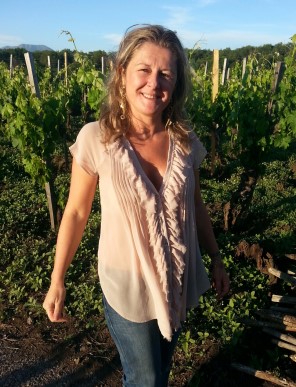
The elevation here is 650 metres, and Silvia pieced the property together, buying adjacent parcels from 10 different local growers, the smallest parcel being just 200 square metres, the largest one hectare. But Silvia insist it is her soils and micro-climate that make this place special: “The particularity of our soils is that they have a fine, thin volcanic sand layer that gives elegance,” she says. “The site is surrounded by lava flows, making for a slightly milder climate too,” she continues, warming to her theme. “In areas with more rock you have stronger wines and higher alcohol. That is why I have planted my younger vineyard on soils with less fine powder and much more lava rock. It is useful for adding a little oomph in less good vintages.”
Silvia’s winemaker and partner in the business, Federico Curtaz, came from working for Gaia in Piedmont, and she laughs when she considers their position as ‘incomers’ to Sicily: “We define ourselves as cautious students, ” she says. “My father was a winemaker in Tuscany, but we are still learning about Etna.”
The vineyard has some white grape varieties scattered throughout that at one time would have been picked and bottled together with the Nerello, but is now bottled separately, though Silvia also has a vineyard near Milo on the east of the mountain, where they source Carricante, as well as some Nero d’Avola from vineyards near Noto, south of Syracuse.
for tasting notes on 10 wines from Fessina
COTTANERA
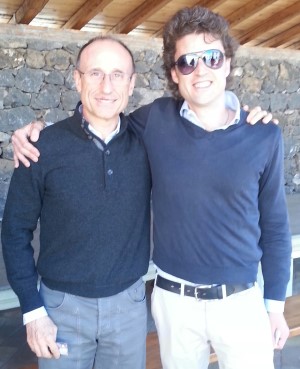
The family already farmed the land where the vineyards are planted. It was historically vineyard land, but had been replanted to hazelnuts as a strategic business decision at a time when Etna produced only cheap, bulk wines. The family changed it back to vineyard, but initially Enzo says it was “high yielding vines, producing large quantities for the market of medium to low quality. In the 1990s we began to rethink the possibilities for bottling quality wine, which led to wholesale changes.” This was largely led by Italian consumer demand for quality wine, which Enzo says grew considerably during the 1990s, as the price for bulk wine fell. Hence it was another business decision to change their focus.
The vineyards were replanted in 1997, with the first vintage of Cottanera in 1999. They planted indigenous varieties, but also Bordeaux varieties and – astonishingly enough – Mondeuse, a rarely seen grape of Savoie in Eastern France, sent by mistake from the nursery, but which they decided to keep (and which was actually very good – see tasting notes below). They also bought two vineyards of Nerello Mascalese and Carricante, which now supply fruit from 35-year-old vines.
They now farm 68 hectares of vineyard at around 700 metres elevation, producing 300,000 bottles which makes them one of Etna’s larger estates. Around 40 hectares are indigenous varieties. One fascinating fact that emerged only after my visit on reading Cottanera’s literature is that their entire vineyard team of 25 is female. Had I known, I would have asked why but that is a mystery to be explained another time. The vineyards are not alberello, but cordon spur trained, with dense planting at 5,700 plants per hectare. All wines are made in stainless steel, and reds are aged in both large ‘botti’ and French oak barriques.
for tasting notes on 9 wines from Cottanera
WIEGNER
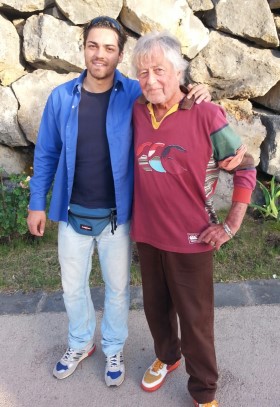
Peter made his money in leather trading, and has lived in Italy for 40 years. It is a family business, producing 15,000 bottles from Nerello Mascalese, Fiano, Aglianico and Cabernet Franc. “The reason they all work is because they all like volcanic soils,” says Peter, before adding, “well, not Cabernet Franc – I planted that just because we like it.”
Sited at 750 metres altitude, almost all of the vines were planted in 2002. They practice strictly organic viticulture in this very well ventilated site, but like many others have chosen not to be certified as organic. Peter is very keen on biodiversity, taking huge pride in his little estate. The yellow flowering ginestra was in full bloom throughout (“It helps pollinate the vines,” says peter), and on slopes he describes as “The Côte d’Or of Etna,” he says they produce “Incredible fruit, right now the apricots are beautiful.”
Marco tells me the wines are made from a very careful vineyard selection of fruit, with a full three weeks of gentle maceration for reds and 15 to 18 months in wood, only the Cabernet Franc in French oak barriques, the rest in big French oak casks. All fermentation is with natural yeasts and wines are kept for a minimum of two years in bottle before release. “We are very proud of being artisans,” says Peter. “We really do hand make our wines.”
for tasting notes on 8 wines from Wiegner
Go to part II – Sicilia en Primeur – wines from across Sicily

